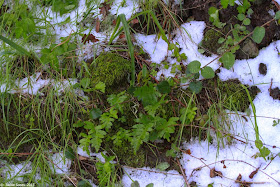Around mid-day, we were treated to an amazing series of showers and thunderstorms, including lightning. If you've been following the blog for a while, you know I can't resist recording thunder. So here you go, two of the better thunder rolls from today. Remember to turn your volume up. If you have headphones, the listening experience is even better with them. (There are a few birds calling, too — you'll hear Oak Titmice and American Crows.)
In the late afternoon we decided to go for a very short walk in Santa Rosa. As we started down the trail, I was puzzled by what looked like ice among the grass. When we looked closer, we realized it was hail!
We had only seen a tiny bit of hail at our house, but this was impressive. In some areas, e.g., under shade and in low spots, the hail was so dense it looked like snow. And then Eric had a brilliant idea:
A hailman! For New Englanders who have been missing snowmen, this was the closest we've come to building one in Sonoma County since moving here 10 years ago. I just wish the hailman didn't melt so quickly! (And if we had known there had been so much hail, we certainly would have brought trays to try sledding. Next time.)
Here are a few more pictures of the hail. This was around 4-5 p.m. I wish I had been there several hours earlier to see the new fallen hail.
Next to the trunk of a buckeye tree:
Surrounding stones next to a creek:
With ferns and moss:
The clouds associated with this thunder and hail were impressive. Two examples after the storms had passed:

















































